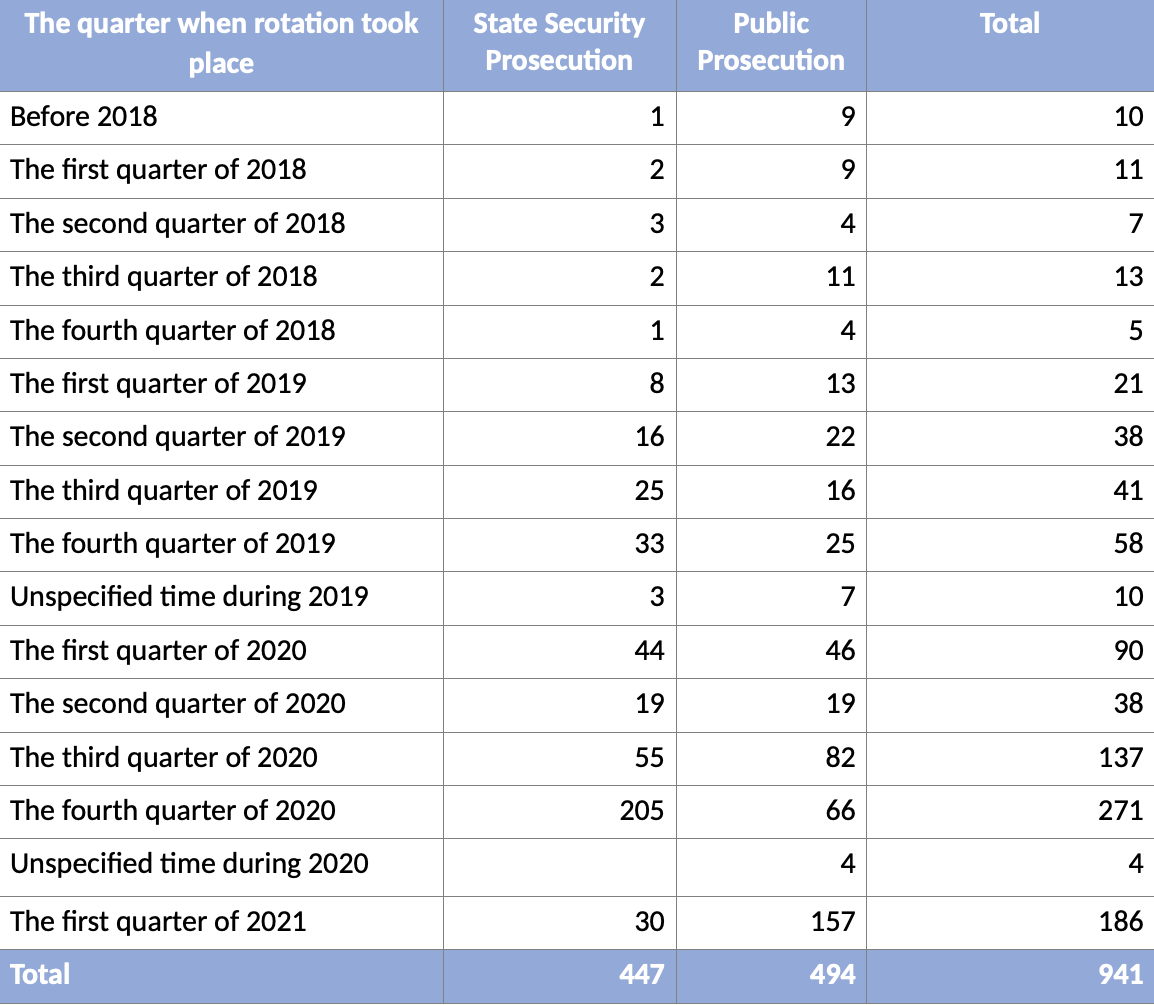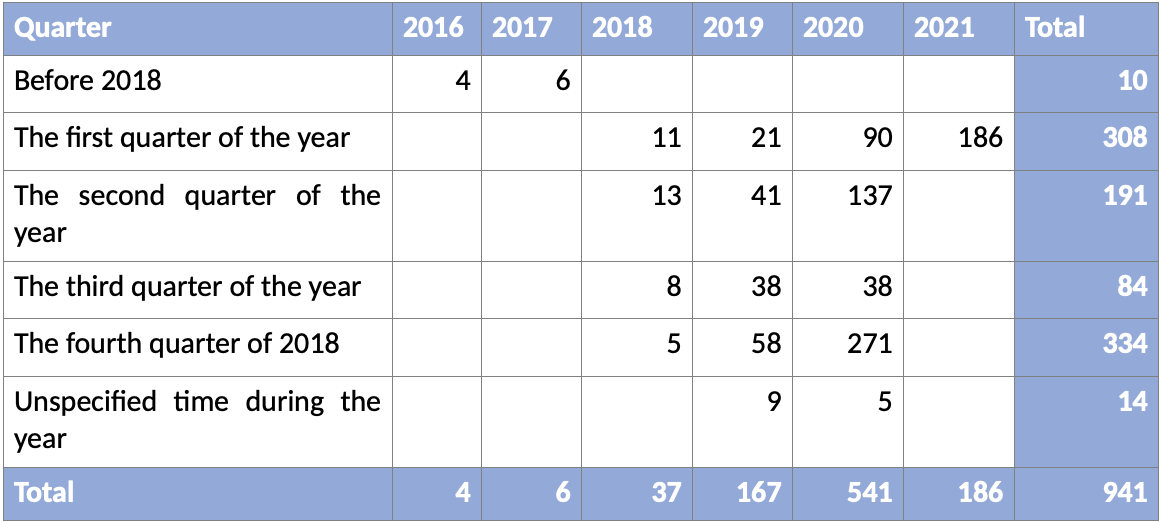.اقرأ المقال بالعربي
Renewed arbitrary—or “rotation” of detention—is the act of re-detaining those who have been already granted a release order after the termination of their sentences, a verdict of acquittal, or otherwise. Egyptian authorities began this practice to a limited extent between 2016 and 2018 before gradually using it on a larger scale in 2018 until it reached its peak by 2020. “Rotation” is still ongoing regardless of the repeated calls by human rights organizations to release the accused that are not involved in acts of violence, especially under the widespread of COVID-19.
It is noteworthy that this practice cannot be separated from other structured series of practices and violations committed by the security authorities, which target the detention of the opponents of the regime and inflict retribution on them on security grounds after July 3, 2013. This practice targets the detention of opponents for indefinite periods without adherence to judicial decisions—an extension of practices that served the same purpose before the January 25 Revolution but now through new mechanisms. “Rotation” has been specifically introduced and widely applied recently to circumvent legal limits on pre-trial detention, which, according to the law, may not exceed two years. In practice, detainees are released before the two-year limit, only to have their detentions renewed in connection with new cases. This renders their detention correct on procedural grounds, despite illegality and lack of evidence used. In some cases, detainees are charged in new cases before being released from their first ones in order to guarantee the continuation of their custody and pre-trial detention for the second case even if they are released for the first one.
In other cases, the “rotation” is pursued in order to keep the detention of activists, jurists, and others, who, in the opinion of security authorities, should not be released despite already being acquitted or having already served their sentences. These new practices represent just another violation of restricting the freedom of citizens without legal basis.
Prior to 2011, Emergency Law No. 162 of 1958 was invoked. Article 3 (b) bis of this law states that “lower state security emergency courts, based on the request of the Public Prosecutor’s Office, may detain anyone about whom there is an evidence of posing a risk to public security for a one-month period subject to renewal.” This article was frequently applied, because security authorities would not conduct investigations during the one-month period prescribed by law; therefore, they pressed charges and renewed detention without legal basis for up to years in some cases.
According to one of the victims, detainees are transferred on a monthly basis from their prison to the headquarters of the National Security Agency in Lazoghly Square for a maximum of one week until a decision to renew their detention for another month is issued. This process took place systematically, mainly targeting those affiliated with Islamist organizations, the Muslim Brotherhood, and other categories of opponents, such as those affiliated with the Revolutionary Socialists. Following the removal of Former President Mohamed Morsi from office on July 3, 2013, security forces targeted those affiliated with Islamic currents in general and the Muslim Brotherhood in particular. This is in addition to a number of detention cases of those affiliated with other currents, which has gradually begun to expand since 2017, specifically after the protests against the Egypt-Saudi Arabia Maritime Demarcation Agreement.
In order for security forces to guarantee the continuation of the detention of those affiliated with Islamic currents and other political opponents for indefinite periods, they followed the following procedural patterns:
- The formation of special terrorist circuits, whose trials were characterized by various egregious violations and mass executions
- The appearance of civilians in military courts, which are known for their harsh sentences and deny detainees an appearance before a competent civilian judge
- The inclusion of the person’s name in many cases—up to five or more—so that if he faces limited one-to-three-year prison sentences in each case, the total term of detention remains prolonged
- The extension of the detention period across many trials—so that even if the defendant is acquitted in all of them, they have already spent a long period in prison, which is a penalty in itself
- Resorting to prolonged pre-trial detention, in some cases, may extend to more than five years
Many victims of these practices have also suffered from the inclusion of their names in new cases and have not been set free after serving their sentences, with no decision to release them by the competent authority.
The expansion in the use of “rotation” as a means to suppress opposition began in 2018. According to Transparency Center for Archiving, Data management and Research (TADMR), during the period between January 1, 2018 and March 15, 2021, 941 cases of rotation were used on 774 victims, bearing in mind that these are the monitored cases only, and that the number of actual cases is much greater than this. Among these victims are:
- 660 victims who were subject to this practice at least once
- 77 victims who were subject to this practice at least twice
- 26 victims who were subject to this practice at least three times
- 9 victims who were subject to this practice at least four times
- 2 victims who were subject to this practice at least five times
- One victim who was subject to this practice at least seven times
The previous statistics show the large number of the victims who suffered from this practice. Besides, they point out how it is carried out many times against the same victim and not only once.
The following tables show the temporal distribution and the gradual increase in the number of cases according to the quarter and the investigation entities the victim was brought before:


It is obvious from the two previous tables that both the State Security Prosecution and the Public Prosecution participate almost equally in the practice of this violation.
Furthermore, the acceleration rate of the expansion of carrying out this practice is also evident,—the gradual increase appears clearly to start from the first quarter of 2018, due to the previously explained reasons.
In this vein, it is noteworthy that there is a clear inverse relationship between a reduction in referring cases to competent courts for consideration and the increased application of pre-trial detention as a key instrument in the suppression and restriction of the freedom of citizens, according to the data of the same center.
Generally speaking, the main patterns of carrying out this practice can be summed up as follows:
- Cases in which the victim obtains a verdict of acquittal then is charged in a new case: 577 cases
- Cases in which the victim serves his sentence then is charged in a new case: 112 cases
- Cases in which the victim obtains a verdict of acquittal then is charged in a new case: 216 cases
- Cases in which new cases are added to the victim during his detention in connection with the main case, whether with the same accusations or with new ones in the same context of the accusations because of which they are detained: 23 cases
- Cases in which the victim is excluded from the case then not released but charged in a new case: 4 cases
- Cases in which the victim obtains a verdict of acquittal, but it is not implemented. Instead, he is recycled in connection with the same case: 2 cases
- Cases in which the victim is granted a pardon by the military governor then recycled in connection with a new case: 2 cases
For example, between case No. 1338 of 2019 and case No. 1413 of 2019 of the Supreme State Security Court—which are related to the events of 20 September 2019—not less than 144 defendants were rotated in new cases after their releases. This is in addition to charging 14 people in the same two cases after their release from previous cases without the referral of any of them to the court. In most cases, victims remain under enforced disappearance for various periods ranging from days to months, before bringing them once more before an investigative entity.
Among the most notable monitored cases of this practice are of two young men Belal Hany Kamal Helal and Khaled Youssry Zaky Mohamed, who were 19 years old when they were detained on January 9, 2015 for alleged membership in a terrorist group. They were acquitted, only to remain under enforced disappearance and be rotated into new cases, and they were charged in September 2016. Prosecution ordered their acquittal, and in October of the same year they were rotated again. The same process was repeated in March 2017, August 2017, and for the fifth time in January 2018 after they were brought before the prosecution, and Khaled Youssry obtained a verdict of acquittal. However, he remained under enforced disappearance for a period and was charged in a case related to the events of the demonstrations of 20 September 2019, although he was in detention during these events. In 2020, a verdict of his acquittal was issued, and then he was detained for a new case later in November of the same year.
According to these patterns, it is obvious that regardless of the entities that issue acquittals— even by pardon by a military governor, the decision at the end is subject to an anonymous non-judicial entity that determines who remains under detention and who is released, circumventing the whole judicial framework.
Security authorities complicit in this practice have followed two main patterns to legalize these them procedurally, which are:
- First, the person is hidden for a period after being released from a previous case. Then, a new post-dated seizure report is prepared as if he had been already released and re-arrested again.
- Second, the person is accused of holding meetings with other detainees in prison or during detention hearings for the purpose of committing a terrorist offense.
It is obvious that these violations are committed systematically and with coordination between and full complicity of the security services represented in the Ministry of the Interior and the National Security Agency in particular, and the judicial authorities represented in both the State Security and the Public Prosecutions. Instead of being entrusted with the safeguarding of the rights of citizens and their protection from any oppression they suffer, the prosecuting authority represented in the Egyptian Public Prosecution has become the one that oppresses them, restricts their freedom, and violates the law in a systematic way.
In addition to its being arbitrary, illegal, and unconstitutional, “rotation” tortures detainees psychologically. Throughout the years of detention, detainees can obtain a verdict of acquittal in each hearing. However, they are not released but rather re-included in new cases, which makes them lose hope in freedom. Consequently, they think that they are detained forever although they may become free at any moment.
Amr Ahmed Ibrahim is an Egyptian human rights activist and founder of the Shafafya Center for Research, Archiving, and Data Management.
